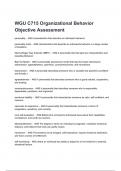WGU C715 Organizational Behavior
Objective Assessment
personality - ANS characteristics that describe an individual's behavior.
personality traits - ANS characteristics that describe an individual's behavior in a large number
of situations
Myers-Briggs Type Indicator (MBTI) - ANS A personality test that taps four characteristics and
classifies Behavior
Big Five Model - ANS A personality assessment model that taps five basic dimensions.
extraversion, agreeableness, openness, conscientiousness, and neuroticism.
extraversion - ANS A personality describing someone who is sociable and assertive (confident
and forceful )
agreeableness - ANS A personality that describes someone who is good natured, cooperative,
and trusting.
conscientiousness - ANS A personality that describes someone who is responsible,
dependable, persistent, and organized.
emotional stability - ANS A personality that characterizes someone as calm, self-confident, and
insecure.
openness to experience - ANS A personality that characterizes someone in terms of
imagination, sensitivity, and curiosity.
core self-evaluation - ANS Bottom-line conclusions individuals have about their capabilities,
competence, and worth as a person.
Machiavellianism - ANS The degree to which an individual is pragmatic, maintains emotional
distance, and believes that ends can justify means.
narcissism - ANS The tendency to be arrogant, self-importance, require excessive admiration,
and have a sense of entitlement.
self-monitoring - ANS where an individual has ability to adjust his or her behavior to external,
situational factors.
,proactive personality - ANS People who identify opportunities, show initiative, take action, and
persevere until meaningful change occurs.
values - ANS Basic convictions that a specific mode of conduct or end-state of existence is
personally or socially preferable to an opposite or converse mode of conduct or end-state of
existence.
value system - ANS A hierarchy based on a ranking of an individual's values in terms of their
intensity.
terminal values - ANS Values that we work towards (happiness, self-respect, family security,
recognition)
instrumental values - ANS Core values that are permanent in nature (honesty, sincerity,
ambition, independence)
personality Job-fit theory - ANS A theory that identifies six personality types and proposes that
the fit between personality type and occupational environment determines satisfaction and
turnover.
power distance - ANS where society accepts that power in institutions and organizations is
distributed unequally.
individualism - ANS where people prefer to act as individuals rather than as members of
groups.
collectivism - ANS A national culture attribute that describes a tight social framework in which
people expect others in groups of which they are a part to look after them and protect them.
masculinity - ANS where culture favors traditional masculine work roles of achievement, power,
and control.
femininity - ANS indicates little differentiation between male and female roles; where women
are treated as the equals of men in all aspects of the society.
uncertainty avoidance - ANS A national culture attribute that describes the extent to which a
society feels threatened by uncertain and ambiguous situations and tries to avoid them.
long-term orientation - ANS A national culture attribute that emphasizes the future, thrift, and
persistence.
, short-term orientation - ANS A national culture attribute that emphasizes the past and present,
respect for tradition, and fulfillment of social obligations. people value the here and now; they
accept change more readily and don't see commitments as impediments to change.
heredity - ANS factors determined at conception; one's biological, physiological, and inherent
psychological makeup.
Perception - ANS A process by which individuals organize and interpret their sensory
impressions in order to give meaning to their environment.
attribution theory - ANS An attempt to determine whether an individual's behavior is internally or
externally caused.
fundamental attribution error - ANS The tendency to underestimate the influence of external
factors and overestimate the influence of internal factors when making judgments about the
behavior of others.
self-serving bias - ANS The tendency for individuals to attribute their own successes to internal
factors and put the blame for failures on external factors.
selective perception - ANS The tendency to selectively interpret what one sees on the basis of
one's interests, background, experience, and attitudes.
halo effect - ANS The tendency to draw a general impression about an individual on the basis
of a single characteristic.
contrast effect - ANS Evaluation of a person's characteristics that is affected by comparisons
with other people recently encountered who rank higher or lower on the same characteristics.
stereotyping - ANS Judging someone on the basis of one's perception of the group to which
that person belongs.
self-fulfilling prophecy - ANS Causing something to happen by believing it will come true.
decisions - ANS Choices made from among two or more alternatives.
problem - ANS A discrepancy between the current state of affairs and some desired state.
rational - ANS Characterized by making consistent, value-maximizing choices within specified
constraints.
rational decision-making model - ANS A decision-making model that describes how individuals
should behave in order to maximize some outcome.




